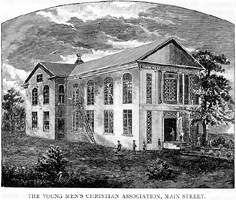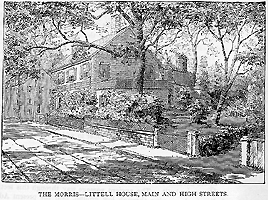
"The building, numbered 5021 [old numbering], on the east side of Main street, is the home of the Young Men's Christian Association. It was formerly the First Presbyterian Church and the grave yard is yet in the rear. The foundation of this institute is chiefly due to the late William Adamson, the founder of the Wakefield Presbyterian Church. He was an elder in the Chelten avenue church...He made himself responsible for its current expenses, and advanced much to purchase the present building...He was the first president. The body was organized January 9, A.D. 1871. The association partially reimbursed Mr. Adamson, but he gave them a large donation. They took possession of the present building in 1873. Before that time they were located at No. 4767 Main street, having the upper stories of that building. The present building is free of debt, a mortgage having been paid during the past year...
"The successful work of the society still goes on. It strives to further the physical, intellectual, social and spiritual improvement of young men. The membership is four hundred and fifty/ There is a library and a large hall, where frequent entertainments take place. A gymnasium, lecture-room, chess and checker room and bath-room afford pleasure and comfort. There is a Boys' Branch with its separate library for their use. A Ladies' Auxiliary has aided in furnishing and embellishing the building. Such good work is needed in training and Christianizing the young, and it deserves high commendation."
"The fine large house of E.H. Butler, the publisher, with its striking portico and conservatory and ample grounds, is a marked feature of the east side of Main street. Formerly John Rose owned the property, and a slaughter house stood on a portion of it...
"In 1831 William Lehman and his wife Mary deeded the property to Thomas Seddon. The house occupied by Lehman and Seddon stood on the street, at the lower end of the lawn. This two-story stuccoed house was demolished by E.H. Butler, father of the present owner. It had a gable roof similar to that of 5041 Main street, which is owned by Edgar H. Butler, but was formerly Mrs. Harkinson's property.
"After Seddon's ownership follows that of William Rose and wife in 1836. Frederick Seckel owned the place from 1845 to 1856, when the father of the present owner obtained it. Mr. Seckel built a house which E.H. Butler altered and enlarged, and in 1874 Edgar H. Butler, his son reconstructed and again enlarged the mansion. In 1885 he improved and beautified it. Six houses have been built by him in the rear. He has increased the homestead by purchase from the Morris-Littell estate on the northwest, and the property now covers about four acres. He also purchased William Williams's property on Haines street. Mr. Butler deserves credit for the manner in which he has improved and kept in order the properties owned by him in Germantown. Such a man is a public benefactor."
"John Smith built a house on the corner of Rittenhouse and Main streets, on the lower side of Rittenhouse. He was the son of Peter Smith, a Pennsylvania German. The house was three stories high. The place now belongs to the Daniel Keyser estate. John Smith was a skillful blacksmith and accumulated a property. His shop was where Engard's confectionary, formerly Harkinson's, now stands."
"Matthias Adam Hogermoed owned the ground where the Town Hall stands. Ward states that an act of Assembly, April 10, 1848, authorized the erection of the Town Hall.--Pennsylvania Magazine of History, No. 3, of Vol. 6, p. 283.
The Town Hall is where Samuel Harvey's residence stood, from whom Harvey street takes its name. His son Samuel died about a year ago. His house was removed to make way for the Hall. It was a stone building, erected about 1800. He owned the land from Main street to Township line. He was one of the early Methodists who assisted the weak society, and was a local preacher. He belonged to the Haines Street Church. The Infant School, on Haines street near Main, was the First Methodist Church in Germantown. The corner stone was laid by Mrs. Dorothy Reger, who also made a prayer at the service. Samuel Harvey was Burgess of Germantown."
"The Engle house was built by Benjamin Engle in A.D. 1758. It is an old-fashioned, pleasant, strongly-built double-house, of stone. The parlor has the old style window seats. The inner doors of yellow pine have panels of white cedar. The old stone out-buildings in the rear were a tannery. A rear room on the first floor has a wainscot over the fire-place and the hall is thus adorned likewise, while the door of the back hall is a double one. Woodwork covers a portion of the wall, but the windows have been modernized."

"The antique English looking house, with its latticed windows, at the southeast corner of Main and High streets, would draw the notice of a passing stranger. My friend, C. Willing Littell, Esq., kindly gives the following sketch of it:--
'This quaint house with its broken angles, and grounds with the comparatively narrow frontage, but extended depth, characteristic of old Germantown, was, from 1812 until January 11, 1853, the date of her death, the residence of Mrs. Ann Willing Morris. Mrs. Morris was a daughter of Charles Willing, a merchant, and a member of a family prominent among the merchants of this city...
'Mrs. Morris was the widow of Luke Morris, a descendant of Anthony Morris, who came to America in 1683, and was second Mayor of the city of Philadelphia in 1703-4. Mr. Luke Morris died March 20, 1802...
'Mrs. Morris was a lady of great mental energy and remarkable attainments. She never lost the vigor and freshness of her early and Revolutionary association, predilections, and principles. One morning, soon after the occupancy of these premises, during the war of 1812-15, a company of troops from Montgomery county, on the march to join the American forces in Philadelphia, halted to rest in front of her house. It was at once thrown open, its supplies were all appropriated, as many of the men who could be accommodated were heartily invited within it, while the steps and curb were covered with refreshments for the defenders of what was to her a sacred cause. She was one of the originators of St. Luke's parish...She was a kind friend and sympathetic neighbor...
'The garden, so protected by its trees and shrubbery as to retain the attractions of its original seclusion, was for many years the beautiful scene of the scientific researches of Miss Elizabeth Carrington Morris, who, retiring in disposition, was an accomplished botanist, and numbered among her many scientific correspondents Dr. William Huttall, Dr. William C. Darlington, of West Chester, and Dr. Asa Gray, of Cambridge, Massachusetts. Her collection of rare plants, cultivated and preserved, was celebrated among many, whose refined taste led them to pursue with her this course of study. Her garden was her Eden, and the greenhouses of Messrs. Thomas Meehan and Henry C. Waltemate, were her favorite resorts.
'In these grounds Miss Margaretta H. Morris pursued her investigations which led, among other results, to the discovery of the habits of that scourge of American agriculturists, the seventeen year locusts, enabled her to predict with accuracy their periodical appearance, and to direct effectual protection against their ravages. She was the first and for many years the only lady elected to membership of the Pennsylvania Academy of Natural Sciences.
'Time, which is transforming Germantown so rapidly, is fast obliterating the memories of its distinguished characteristics. On the premises, which form the subject of this sketch, before their occupation by Mrs. Morris, near the boundary line of Mr. E.H. Butler stood an old house, once the residence of Fraley, some of whose descendants yet remain in Germantown, who was a pupil of Dr. Christopher Witt...a physician of no ordinary acquirement...Fraley was an expert and valuable herb doctor...
'...Both these ladies [the Morris sisters] were among the founders of St. Michael's parish, and among its most liberal contributors. Miss Elizabeth Carrington died February 12th, 1865, and Miss Margaret Hare Morris, May 29th, 1867, in their old homestead...'"
"Before Germantown Road was opened, the oldest part of the present Haines residence was built. The ancient passage way through this section was an Indian track, running through low ground, near the present Adams street. The end of the house adjoining the street was probably built after the opening of the road, as formerly a door and windows opened upon it. The name "Wyck" comes from an English residence. It means white, and by a coincidence suits this very white house.
"The casual passer-by cannot but be struck with the quaint beauty of the old white two-story rambling mansion. The house is a delightful antique, and the air of antiquity has been well preserved.
"A peculiar opening in the front forms a recess by reason of certain alterations in the building. The house is entered by a door which faces the yard. The fact that the house stands endwise to the street gives it an individuality which was unstudied, but makes a picturesque idea for artists to imitate. The ancient brass knocker, which supplements the modern bell, is in keeping with the surroundings.
"Within, the rooms are light and pleasant. The old fire-place yet does duty. The antique, dull looking glass Wister goblet is yet in its old home. There is a pretty kitchen with its small window panes and brick floor. The fine old door, with its strap hinges, has been worn at the handle by the many who have opened and closed it in the years that are gone. The stone step is deep indented where generations have trodden upon it. The ample yard with its shrubbery, and the projecting chimney with it vines, make a pretty picture.... [Quoting from Townsend Ward manuscript]
'There can be but little doubt that the house at Wyck was built by Direk Jansen before 1700, and perhaps begun earlier by Hans Millan, and that it is, therefore, perhaps the oldest house in Germantown. Considerable additions were made to it in the last century, and some alterations about sixty years ago. At that time a huge chimney stack occupied the center of the older half of the building. When this was taken down two large ovens in it were also removed, one of which had been walled in, so that its existence was unknown by the residents. With the material of the chimney and ovens there was built an extensive wall at the foot of the lawn. It is a striking looking building, standing with the gable end to the avenue, its front of eighty feet facing south-eastwardly. It width varies from twenty feet to thirty. Of immaculate white, with a chimney stack outside, this house situated among the fine trees that ornament extensive grounds, is one of the many agreeable features of Germantown. Of course Wyck bore its part in the battle, and its floor is yet stained with the blood of the wounded soldiers who were carried into the house during the engagement.'"